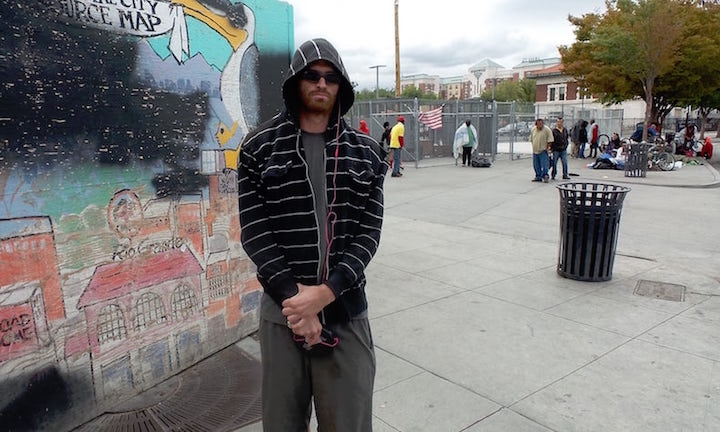
Rio Grande Street, the epicenter of homelessness in Salt Lake City. Photograph: Chad Kirkland for the Guardian
The streets around Salt Lake City’s downtown emergency shelter have long been home to hundreds of homeless people.
In recent weeks, though, nearly all seem to have vanished following a police operation. Local residents are mystified as to where they’ve gone.
The Salt Lake City police chief, Mike Brown, said he had visited parks and the Jordan river, which threads its way to the Great Salt Lake and has homeless camps dotted along its banks, but he hadn’t seen an influx from downtown. Sgt Brandon Shearer has been up in a police helicopter looking for camps and seemed equally perplexed when asked where the people had gone. “I don’t know,” he said. “That’s a good question.”
Advocates, for their part, fear a humanitarian crisis is brewing.
The unfolding drama is all the more remarkable considering that several years ago, national media reports published claims by Utah that it had “won the war” on homelessness there, at least when it came to housing those who had been outside the longest. Jon Stewart ran a laudatory piece titled “The homeless homed”. But the picture wasn’t quite that simple.
While the country’s most prominent homeless crises are in coastal cities – New York, San Francisco, Los Angeles – the mountain-ringed capital of the Mormon church has also long struggled to house or, in the view of some, has politely ignored its homeless population.
The Republican legislature in Utah is fond of the philosophy of pulling yourself up by your bootstraps, and struggling not-for-profit groups pick up the slack when it comes to homelessness funding.
Rather than ending homelessness, the city in fact housed a subset of its homeless residents, an important step but only an intermediary one in its alleviation efforts. Since then, as rents have risen and the minimum wage has remained stagnant, more and more families have found themselves on the street. A count last year found about 2,200 people in the region in total on any one night.
In recent months, Salt Lake City has been convulsed by the situation around the downtown shelter, called the Road Home, located in a onetime warehouse district now host to high-end condos and shops.
Even though officials say most of those living there are blameless – forced there by economic circumstances, mental health issues or opioid addictions – the area has been prone to violence. Police shot a teenager wielding a metal broomstick handle last year, and there were three unrelated killings in July and early August, one involving an unprovoked attack on a homeless man with a paving stone.
As a result, in mid-August, Utah flooded the area with law enforcement officers as part of a two-year, $67m public-safety operation. “You throw 150 cops in there, it’s going to ruin the party,” Brown, the police chief, said dryly.
Cue the abrupt dispersal of many of the downtown homeless residents to parts unknown. More than 1,200 people have been arrested, over half on drug charges, according to police, but 900 were later released to the streets. Officials leading the operation pledged to provide help for homeless residents in the form of treatment, housing and jobs. But in the weeks after the launch, municipal and state officials could only line up 37 treatment beds.

Zach Curry stands by the men’s side of the Road Home shelter in Salt Lake City. Photograph: Stephen Dark for the Guardian
One theory holds that the former inhabitants of the area left the state, another that they somehow found homes, yet another that they dispersed into various neighborhoods.
Homeless people leaving a major jail have been reported as far afield as the airport and empty fields on the west side of the city. “The rhetoric from the mayor and policy workers was ‘We’re trying to help,’” said a west side activist, Michael Clara. “Well, you should help them downtown. Don’t scatter them and then try to help.”
An outreach worker with Volunteers of America, Ethan Sellers, who is based at the main downtown library, said he had struggled to address the fears of those with schizophrenia. “You’re trying to help them understand they’re not under attack.”
Advocates and community activists are anxious about the months to come. Few of the people arrested and then released have returned to the Road Home shelter, and the freezing winter weather is approaching.
The long term impact of the sweep is not year clear. Pamela Atkinson, an acclaimed local homeless advocate, said that while some of the inhabitants had left the state, others “of my homeless friends” have started to return to the shelter. “Now it’s safer, they’ve come back.”
“They’ve cleaned the place up,” said Zach Curry, who has been homeless for 10 years, and was hanging out by the shelter listening to a battered portable CD player. “People were committing suicide on drugs left and right. It was getting a bad rep for Salt Lake City.” He thinks the continuing police presence is challenging, “but it’s got to be done. That’s what a lot of us think about it.”
While observers continue to wonder what has become of the population who lived around the Road Home until only last month, the state is transforming the physical landscape there, even though it plans eventually shutter the shelter and open three smaller ones in the region.
Any homeless people who want to return are welcomed back – but there are now 10ft high chain link fences and floodlights that at night render the shelter akin to a high-security border crossing.
Or perhaps a prison. While officials describe part of a recently blocked off street in front of the shelter as a “safe space” where vulnerable, drug-free people can get help, social workers have taken to calling it “the yard”.
www.theguardian.com/us-news/2017/sep/22/salt-lake-city-homeless-people-missing
Source Article from http://feedproxy.google.com/~r/ASheepNoMore/~3/M8PFqKOoTGY/
 RSS Feed
RSS Feed















 September 24th, 2017
September 24th, 2017  Awake Goy
Awake Goy  Posted in
Posted in  Tags:
Tags: 













